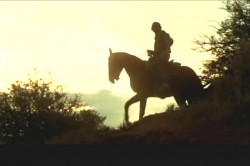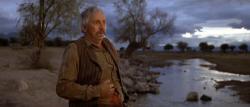Reviews
Jim Jarmusch
USA, 1995
Credits
Review by Katherine Follett
Posted on 23 April 2013
Source Netflix Instant
Categories Acid Westerns
Myths tell us about the values of a society. And Westerns, with their formulas and archetypes, with their moral focus and hero’s journeys, are prime American myths. According to Westerns, Americans value individualism; they value personal morality over law; they see justice in violence; they presume that capitalism and industry will prevail. Or, at least, that’s what Americans valued when Westerns had their heyday in the middle of the 20th century. Toward the end of that century, as American values shifted, or at least came into question, traditional Westerns began to seem outdated. Many filmmakers revisited them with the intention of recasting American myths in the light of new values.
This is the larger context of the acid Western, and Dead Man, from 1995, is a beautiful example. The film gets much of its strange power from the incredibly perceptive choice of director Jim Jarmusch to update American myths not simply with the values of the 21st century, but with a close examination the other cultures of the historical Old West. Dead Man takes American myths and braids them with the myths we lost when we displaced and disenfranchised the Native Americans.
Dead Man’s story is simple: A timid accountant named William Blake arrives in the western town of Machine, having been offered a job. The job doesn’t exist, and after drowning his sorrows, Blake inadvertently finds himself in a gunfight, killing a man and receiving a mortal wound himself. He flees on a stolen horse, coming under the care of an Indian named Nobody, while the most powerful man in Machine pursues him for his crimes.
Like many Westerns, the crux of Dead Man is a journey—Blake’s journey with Nobody. More than anything, it’s a journey to death, literally and symbolically. Very quickly after being shot, Blake learns from Nobody that his bullet wound is fatal. Nobody declares that Blake will “become a killer of white men,” and that his weapon will replace his tongue, writing his poetry in blood. Over the course of the film, nearly everyone Blake speaks to dies by his hand. After his first murder, a meteor streaks across the sky, signaling that spiritual events are afoot; before his second, lightning shatters the night. While brutal, many deaths in the film include beautiful aesthetic motifs. Blake’s female companion, Thel, and her fiancée, die in cascades of white paper flowers. A sheriff falls into an extinguished fire pit, his head ringed with rays of kindling, a halo that another character compares to a religious icon. When Nobody and a bounty hunter, Cole Wilson, fire upon each other, they fall simultaneously, balletically, at the edge of the sea. The killings of classic Westerns are recast as rituals. Blake has become the embodiment of death.
Nobody serves as Blake’s guide into his new role, drawing him away from the white man’s world and into an alternate set of myths. Upon hearing Blake’s name, Nobody takes him for a reincarnation of the British poet and painter, and declares that he will lead him back to the place where spirits come and go. He denies Blake food, and, after taking peyote and seeing the visage of death in Blake’s face, leaves him to travel alone. While alone, Blake gazes upon a dead tree while urinating. He also finds a dead fawn, and mixes its spilled blood with his own. He sees death in nature, and combines himself with it, and when he emerges, finding Nobody again, he seems newly at ease with bringing death and facing his own.
Blake has moved into a new world, a strange mirror image of the one he left, governed by new values that are inexplicable to him. One night, he finds himself suddenly surrounded by warriors in face-paint. They disappear into the blackness, and the next morning, he stumbles upon their white victims. Clearly, the Indians intentionally spared him for some reason. His pursuer, the soulless, black-hatted bounty hunter Cole Wilson, receives an arrow wound to the chest in the same spot where Blake was shot with “white man’s metal.” The film is bookended by shots of Blake moving down a long avenue, with strange images of death on all sides. In the first scenes, in the boomtown of Machine, men build coffins and skin animals in the storefronts. In the Native village where Nobody brings him, he sees “sky burials” with corpses lain out the open, and he rests on a giant whale scapula that resembles a fainting couch. Both scenes include women rocking infants; in both, we get an impression not of beginnings or new hope, but a continuing cycle that will inevitably return to death. In Machine, it feels like degradation. In the Native village, it seems more natural. In the white settlement, death is unseen, or it is part of commerce; in the Native village, death is open. Nobody describes a shaman in the village as “a great builder of sea canoes,” the canoe in this case being Blake’s coffin. Death is cast as a journey, an embarkation, or perhaps a return, to another plane.
Jarmusch strongly suggests that Native cultures have a much richer way of dealing with death than Americans do. Americans are notoriously clumsy when talking about death, especially in spiritual terms. For all the violence in traditional Westerns, death can feel like a side effect: bloodless, quick, and more often than not, deserved. It’s a plot point, rather than an inevitable stage of life. Yet for all the book-matched imagery in Dead Man, Jarmusch doesn’t simply re-cast a western with Indians as the spiritually-aware good guys and white man as ignorant and bad, Dances With Wolves-style. Blake’s journey is hallucinatory, confusing, and above all, foreign. American myths have been blended with and twisted by Native myths that we don’t understand. Jarmusch does not spell them out for us, leaving them, as the Native languages, un-subtitled.
The specificity and accuracy of the Native characters, languages, costumes, and cultures is a critical element of this “foreign” feeling. The complexity of Native American societies has not been simplified for a white audience; Jarmusch even mentions in-jokes intended specifically for a Native audience, such as the recurring mention of sacred tobacco. It is only our guide, our liaison, Nobody, who resembles the generic “Indian” we’ve come to expect from Westerns. A mix of tribes and cultures, he wears the feathered headdress of the plains, picks Blake up in the desert, and journeys to the rainforest coastlands of the northwest, spouting spiritual phrases that are in fact British romantic poetry. This “pan-Indian” guides both Blake and the viewer toward a more complex reality that Nobody knows we will not actually be able to fully understand.
Great Spirit forbid that I give the impression that Dead Man is a joyless slog through the mythology of mortality. Jarmusch brings his slightly crude humor and his taste for pop-culture cameos (Iggy Pop in a dress and bonnet is a favorite). Nobody is a wonderfully realized character and excellent companion, referring to William Blake repeatedly as “stupid fucking white man.” Cole Wilson, bounty hunter, brings cheap kills and gore. I have to mention the score, reverb-heavy guitar courtesy Neil Young, only because it is flawless. But this is one of Jarmusch’s heaviest films, and it’s a serious consideration of abstract and symbolic ideas; talking about them is inevitably more heavy-handed than seeing them through imagery. Dead Man reminds us that imagery contains the power of myth, and that we reinforce our culture by repeating those myths. As a “psychedelic” western, an alternate image, it points toward the plurality and complexity we dismiss when we repeat our own myths to the exclusion of others. It is a revision, in the best sense of that word, casting what seemed simple and familiar as in fact irreducible, strange, and beautiful.
More Acid Westerns
-

Ride in the Whirlwind
1965 -

The Shooting
1966 -

El Topo
1970 -

The Hired Hand
1971 -

The Last Movie
1971 -

Greaser’s Palace
1972 -

Bad Company
1972 -

Ulzana’s Raid
1972 -

Jeremiah Johnson
1972 -

Pat Garrett & Billy the Kid
1973 -

Kid Blue
1973 -

Dead Man
1995
We don’t do comments anymore, but you may contact us here or find us on Twitter or Facebook.



